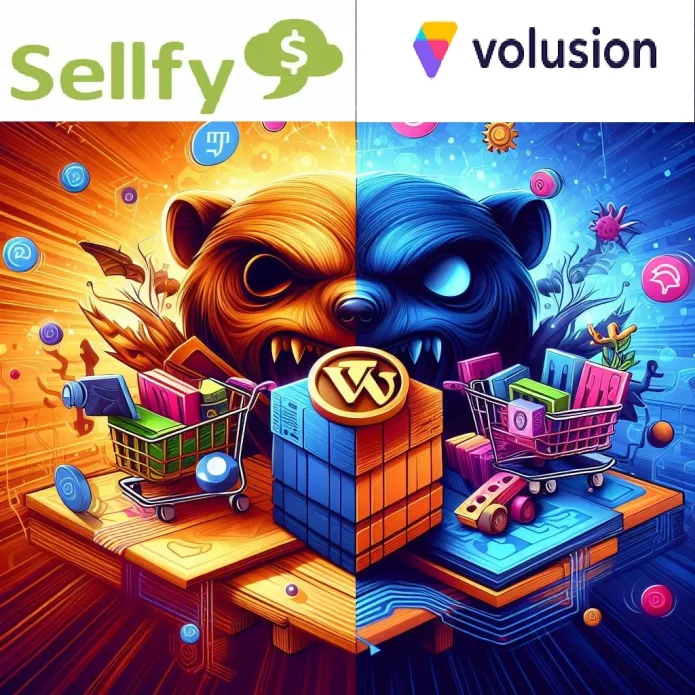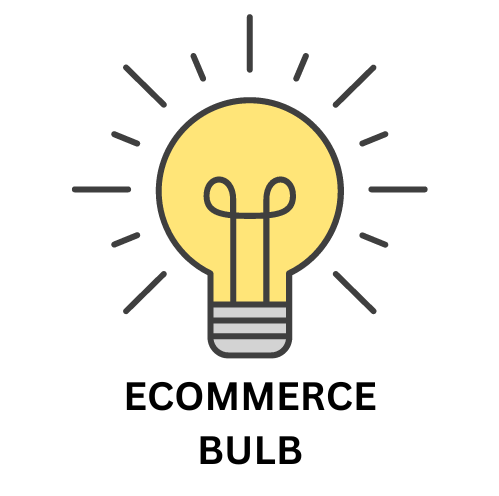In order to decide which ecommerce platform to use, Sellfy vs Volusion. A detailed comparison between features must be thoroughly done. If you want to decide which eCommerce platform to choose, there are many things to consider.
These are some examples of these factors:
- Cost.
- SEO friendliness.
- Page load speed.
- Canonical website URL.
- Indexing Control.
- Customizable HTML capabilities.
- Sitemap Generator.
- Integration with Google Analytics.
- Product Tagging and Categorization.
- Batch Uploading.
- Mobile Optimization.
- Built-in Blogging and Marketing Features.
- Social Sharing Buttons.
- Content Management Capabilities.
- Discount and promotion code tools.
- Easy to use Checkout.
- Reporting tools and custom reports.
- Integration of email marketing tools.
- Multiple payment options.
- Flexibility to add new eCommerce features.
- Exclusive features.
- Cons and pros.
Here we’ll discuss these factors to help you decide which platform is better for you, Volusion or Sellfy. And at the end of the discussion, we’ll recap and make a comparison for the scores of all these points to find out which eCommerce platform has the higher score, so that you’ll have a good view about both of them.
Read Further: Top 6 Sellfy Reviews

Pricing (Sellfy vs Volusion):

Both Sellfy and Volusion are popular e-commerce platforms with their own strengths and weaknesses when it comes to pricing. To give you a comprehensive comparison, let’s break down their pricing plans and features:
Sellfy:
- Free plan: This plan allows you to sell up to 10 digital products, with a 10% transaction fee. You can also create one custom domain and email list.
- Starter plan: For $19 per month, you can sell unlimited digital products, with a 3% transaction fee. You also get custom branding, discount codes, and email marketing features.
- Plus plan: For $49 per month, you get all the features of the Starter plan, plus physical product sales, abandoned cart recovery, and upsells.
- Pro plan: For $99 per month, you get all the features of the Plus plan, plus subscriptions, memberships, and priority support.
Volusion:
- Basic plan: For $29 per month, you can sell up to 100 products, with a 3% transaction fee. You also get a custom domain, email marketing, and basic SEO tools.
- Plus plan: For $79 per month, you can sell up to 1,000 products, with a 2% transaction fee. You also get abandoned cart recovery, upsells, and more advanced SEO tools.
- Pro plan: For $159 per month, you can sell up to 10,000 products, with a 1% transaction fee. You also get product reviews, customer segmentation, and priority support.
- Enterprise plan: For a custom price, you get unlimited products, no transaction fees, and custom features tailored to your business needs.
Here’s a quick comparison table to help you see the key differences:
| Feature | Sellfy | Volusion |
|---|---|---|
| Starting price | Free | $29 per month |
| Transaction fees | 10% (Free plan), 3% (Starter & Plus), 0% (Pro) | 3% (Basic), 2% (Plus), 1% (Pro), 0% (Enterprise) |
| Max products | 10 (Free), Unlimited (Starter & Plus), 10,000 (Pro) | 100 (Basic), 1,000 (Plus), 10,000 (Pro), Unlimited (Enterprise) |
| Physical products | No (Starter & Plus), Yes (Pro) | Yes |
| Subscriptions | No (Starter & Plus), Yes (Pro) | Yes |
| Abandoned cart recovery | No (Starter), Yes (Plus & Pro) | Yes |
| Upsells | No (Starter), Yes (Plus & Pro) | Yes |
| Email marketing | Yes | Yes |
| SEO tools | Basic | Basic |
| Priority support | No (Starter & Plus), Yes (Pro) | No (Basic & Plus), Yes (Pro & Enterprise) |

SEO Capabilities (Sellfy vs Volusion):

SEO Capabilities: Sellfy vs. Volusion
Both Sellfy and Volusion offer built-in SEO features to help your online store rank higher in search engine results. However, they cater to different needs and priorities. Here’s a breakdown:
Sellfy:
- Strengths:
- Simplicity: Easy-to-use interface for basic SEO tasks like editing page titles, meta descriptions, and image alt tags.
- Mobile-friendly: Responsive themes ensure your store looks good and functions well on all devices, a crucial SEO factor.
- Content marketing: Built-in blog platform allows you to create SEO-friendly content like articles and product descriptions.
- Weaknesses:
- Limited control: Fewer advanced SEO features compared to Volusion, making it harder to fine-tune optimization for specific keywords.
- No sitemap generation: You need to rely on third-party tools for creating and submitting sitemaps to search engines.
- Backlink generation: Lacks built-in tools for actively building backlinks, a crucial off-page SEO factor.
Volusion:
- Strengths:
- Advanced SEO tools: Offers features like keyword research, URL redirects, canonical tags, and robots.txt editing for granular control over search engine crawling and indexing.
- Automatic sitemap generation: Creates and submits sitemaps to search engines, ensuring your store’s pages are discoverable.
- Built-in blog and landing page tools: Powerful platform for creating SEO-rich content and targeted landing pages.
- Weaknesses:
- Complexity: Learning curve can be steeper for beginners due to the wider range of options and settings.
- Cost: Higher priced plans offer more advanced SEO features, which can be a barrier for entry for some businesses.
- Technical knowledge: Some advanced SEO features might require understanding of technical concepts like robots.txt or canonical tags.
Choosing the right platform for SEO:
- For beginners: Sellfy’s ease of use and focus on essential SEO tasks might be sufficient.
- For SEO-focused businesses: Volusion’s advanced tools and granular control offer more potential for optimizing your store for specific keywords and achieving higher search engine rankings.
- For budget-conscious businesses: Consider Sellfy’s lower pricing, but factor in the need for additional SEO tools if you require more advanced features.

PageLoad Speed (Sellfy vs Volusion):

Here’s a comparison of Sellfy and Volusion’s page load speeds, considering various factors:
1. Server Infrastructure:
- Sellfy: Utilizes Amazon Web Services (AWS), known for reliability and speed.
- Volusion: Uses proprietary servers, which may have varying performance depending on configuration and load.
2. Website Optimization:
- Sellfy: Emphasizes lightweight code and image optimization for faster loading.
- Volusion: Offers optimization features, but their effectiveness depends on user implementation.
3. Content Delivery Network (CDN):
- Sellfy: Includes a global CDN, distributing content across multiple servers for faster delivery to users worldwide.
- Volusion: Offers CDN integration on higher-tier plans, but it’s not built-in on all plans.
4. Theme Selection:
- Sellfy: Provides themes designed for speed and responsiveness.
- Volusion: Offers a wider range of themes, but some may be less optimized for loading speed.
5. Third-Party Apps:
- Sellfy: Limits third-party apps, potentially reducing external factors that could slow down loading.
- Volusion: Has a larger app marketplace, but excessive app usage can impact performance.
6. Mobile Optimization:
- Both platforms: Prioritize mobile responsiveness for fast loading on mobile devices.
General Observations:
- Sellfy: Often praised for its fast loading times, typically loading pages under 2 seconds.
- Volusion: User experiences vary, with some reporting slower loading times, especially for larger stores with many products.

Canonical Website URL (Sellfy vs Volusion):

Sellfy:
- Automatic canonicalization: Automatically adds canonical tags to product and category pages, pointing to the preferred URL version.
- Manual adjustment: Allows for manual editing of canonical tags for individual pages if needed, providing flexibility for custom setups.
- User-friendly interface: Offers a straightforward interface to manage canonical tags, even for those without technical expertise.
Volusion:
- Manual canonicalization: Requires manual configuration of canonical tags for each page, which can be time-consuming for large stores.
- Advanced settings: Provides options for setting canonical URLs for product filters, search results, and other dynamic pages, enabling granular control.
- Technical knowledge: Understanding of canonical tags and their usage is essential for proper implementation.

Indexing Control (Sellfy vs Volusion):

Sellfy:
Limited control:
- No robots.txt editor: Lacks a built-in tool to directly control which pages search engines can access.
- Manual meta tag adjustment: Requires manual editing of meta tags to instruct search engines not to index certain pages.
- Reliance on third-party apps: May need to use external apps for more granular indexing control.
Volusion:
More control:
- Built-in robots.txt editor: Provides a user-friendly interface to manage indexing permissions.
- Granular control: Allows selective noindexing of product pages, category pages, search results, and specific URLs.
- Advanced settings: Offers options to control crawling frequency and prevent specific search engines from accessing your site.

Customizable HTML Capabilities (Sellfy vs Volusion):

Sellfy:
- Limited customization:
- Provides basic HTML editing options for product descriptions, landing pages, and blog posts.
- Allows for custom CSS injection to modify styling.
- Lacks access to core template files for extensive structural changes.
Volusion:
- More extensive customization:
- Offers a built-in HTML editor for full control over page content and structure.
- Provides access to template files for advanced modifications.
- Supports custom JavaScript for adding dynamic elements and functionality.
Key considerations:
- Level of expertise:
- Sellfy’s simpler approach is suitable for those with basic HTML/CSS knowledge.
- Volusion’s versatility caters to users with more experience in web development.
- Customization needs:
- If you require minor changes to content and styling, Sellfy may suffice.
- For extensive layout adjustments, code integrations, or unique design elements, Volusion offers greater flexibility.
Additional features:
- Sellfy:
- Customizable checkout pages for branding and conversion optimization.
- Integration with Zapier to connect with external apps and services.
- Volusion:
- Customizable product pages for unique product experiences.
- Built-in blog platform for content marketing.

Sitemap Generators (Sellfy vs Volusion):

Sellfy:
- No built-in sitemap generator: Lacks a native tool to automatically create and submit sitemaps.
- Third-party solutions: Relies on external apps or services to generate sitemaps.
- Manual creation: Option to manually create an XML sitemap and submit it to search engines, but requires technical knowledge.
Volusion:
- Built-in sitemap generator: Offers a tool to automatically create sitemaps for product pages, category pages, and other important URLs.
- Automatic submission: Can automatically submit sitemaps to major search engines like Google and Bing.
- Customization options: Allows control over which pages are included in the sitemap and the frequency of updates.
Key considerations:
- Ease of use: Volusion’s built-in sitemap generator is more convenient and user-friendly, eliminating the need for external tools.
- Control: Volusion offers more customization options for tailoring sitemaps to specific needs.
- Integration: Sellfy’s reliance on third-party apps might require additional setup and management.
Conclusion:
Volusion’s built-in sitemap generator simplifies the process of creating and submitting sitemaps, offering more control and convenience compared to Sellfy’s reliance on third-party solutions. However, both platforms can effectively generate sitemaps with proper implementation and attention to best practices.

Integration With Google Analytics (Sellfy vs Volusion):

Integration with Google Analytics: Sellfy vs. Volusion
Both Sellfy and Volusion offer integration with Google Analytics, a crucial tool for tracking website traffic and user behavior. However, their approaches differ in terms of ease of use, features, and level of control.
Sellfy:
- Easy setup: Automatic integration with Google Analytics through a simple wizard.
- Limited features: Provides basic tracking of page views, visits, and conversions.
- Less control: Offers limited options for customizing tracking and analyzing data.
Volusion:
- Manual setup: Requires manual insertion of the Google Analytics tracking code into the website template.
- Advanced features: Supports advanced tracking options like ecommerce tracking, custom dimensions and metrics, and goal setting.
- More control: Provides greater control over data configuration and analysis through Volusion’s analytics dashboard.
Here’s a table summarizing the key differences:
| Feature | Sellfy | Volusion |
|---|---|---|
| Setup | Automatic | Manual |
| Features | Basic | Advanced |
| Control | Limited | More control |
| Ease of use | Easy | Requires technical knowledge |
Choosing the right platform:
- For beginners: Sellfy’s automatic integration and simple interface make it easier to get started with basic Google Analytics tracking.
- For data-driven businesses: Volusion’s advanced features and granular control offer deeper insights into user behavior and website performance, essential for data-driven decisions.
- For budget-conscious businesses: Sellfy’s lower pricing might be preferable if advanced analytics features are not a top priority.
Additional factors to consider:
- Technical expertise: Volusion’s manual setup and customization options might require some technical knowledge.
- Integration with other tools: Both platforms offer integrations with other marketing and analytics tools, which might influence your choice.

Product Tagging and Categorization (Sellfy vs Volusion):

Sellfy:
- Simple approach:
- Basic product tagging for keyword association and organization.
- Single-level categorization with unlimited categories.
- Easy-to-use interface for managing tags and categories.
Volusion:
- More comprehensive features:
- Advanced multi-level categorization for structured product hierarchies.
- Custom product attributes for detailed product specifications.
- Option for unlimited tags for extensive keyword optimization.
- Filters for refined product navigation and search.
Key considerations:
- Inventory size:
- Sellfy’s simpler approach might suffice for smaller inventories with straightforward organization.
- Volusion’s comprehensive features are better suited for larger inventories with complex categorization needs.
- Product variety:
- Volusion’s ability to create multi-level categories and custom attributes effectively handles diverse product types with varying attributes.
- SEO optimization:
- Volusion’s extensive tagging and filtering capabilities can enhance search engine visibility and user experience.
Additional features:
- Sellfy:
- Option to create product bundles for grouped sales.
- Volusion:
- Integration with third-party product catalog management tools for advanced organization.
Conclusion:
The ideal platform depends on the complexity of your product catalog and your focus on SEO and user experience. Sellfy provides a simpler solution for smaller inventories, while Volusion offers a more robust approach for larger inventories and advanced categorization needs. Carefully assess your requirements to select the platform that best supports your product organization and search optimization goals.

Batch Uploading (Sellfy vs Volusion):

Sellfy:
- Limited batch uploading:
- No native tool for uploading multiple products simultaneously.
- Requires manual entry for each product, which can be time-consuming for large inventories.
- Option to import products from a CSV file, but functionality is limited.
Volusion:
- Robust batch uploading:
- Offers a built-in tool for uploading multiple products at once, saving time and effort.
- Supports CSV and XML file formats for importing product data.
- Allows customization of data fields to match your product catalog structure.
- Provides options to schedule batch uploads for automatic updates.
Key considerations:
- Inventory size:
- Volusion’s batch uploading becomes crucial for managing large inventories efficiently.
- Sellfy’s manual approach might be viable for smaller product ranges.
- Frequency of updates:
- If you frequently add or update products, Volusion’s batch capabilities streamline the process.
- Technical expertise:
- Volusion’s batch uploading might require some technical knowledge, especially for customization and error handling.
Conclusion:
Volusion excels in batch uploading, offering a time-saving solution for managing large inventories and frequent updates. Sellfy’s manual approach might be suitable for smaller stores or those with infrequent product changes. Assess your inventory management needs and technical expertise to select the platform that aligns with your workflow and efficiency goals.

Mobile Optimization (Sellfy vs Volusion):

Both Sellfy and Volusion prioritize mobile optimization to ensure your online store delivers a seamless experience on smartphones and tablets. Here’s a comparison of their key features:
Sellfy:
- Responsive themes: All themes offered by Sellfy are built with mobile responsiveness in mind, automatically adjusting layouts and elements for smaller screens.
- Mobile-friendly checkout: Checkout process is optimized for mobile devices, ensuring a smooth purchase experience on the go.
- Easy to manage: Simple interface allows for adjustments to product descriptions and images for optimal mobile viewing.
- Faster loading times: Sellfy generally offers faster loading times, which is crucial for mobile users with limited data plans.
Volusion:
- Advanced customization: Volusion provides more control over mobile optimization via theme settings and custom CSS adjustments.
- Mobile site preview: Built-in feature allows you to preview your store’s appearance on different mobile devices.
- AMP integration: Option to integrate Accelerated Mobile Pages (AMP) for even faster loading on mobile devices.
- App Store and Google Play integrations: Build branded mobile apps for your store directly within Volusion (paid add-on).
Key considerations:
- Technical expertise: Volusion’s advanced features might require some technical knowledge for effective mobile optimization.
- Level of customization: If you need precise control over mobile layout and functionality, Volusion offers more options.
- Budget: Volusion’s app integrations and AMP features come at an additional cost, while Sellfy’s mobile optimization is included in all plans.
Conclusion:
Both Sellfy and Volusion offer strong mobile optimization, but the best choice depends on your needs and technical abilities. Sellfy provides a user-friendly solution with fast loading times, suitable for those with less technical expertise. Volusion caters to those seeking more control and advanced features, including the option for dedicated mobile apps, but requires some technical knowledge for full utilization. Evaluate your priorities and technical skills to choose the platform that best optimizes your store for a successful mobile experience.

Built-in Blogging & Marketing Features (Sellfy vs Volusion):

Both Sellfy and Volusion offer built-in features for blogging and marketing, but cater to different levels of needs and complexity. Here’s a comparison to help you choose:
Sellfy:
- Basic blogging platform: Create simple blog posts to engage your audience and share updates.
- Email marketing tools: Design and send email campaigns to promote products, announce discounts, and nurture leads.
- Social media integrations: Easily share your content and products on popular social platforms.
- Landing page builder: Create basic landing pages to capture leads and promote specific products or campaigns.
Volusion:
- More advanced blogging platform: Richer editing tools, scheduling options, and SEO features for enhanced content creation.
- Extensive email marketing capabilities: Design automated email sequences, segment your audience, and track campaign performance.
- Powerful marketing tools: Built-in coupon codes, abandoned cart recovery, product upsells, and loyalty programs.
- Social media marketing tools: Schedule social media posts, run contests, and track engagement metrics.
- Advanced analytics: Gain deeper insights into website traffic, customer behavior, and campaign performance.
Key considerations:
- Content marketing needs: If you plan to regularly create blog posts and content, Volusion’s richer features might be beneficial.
- Email marketing complexity: For sophisticated email campaigns with automation and segmentation, Volusion offers more options.
- Marketing budget: Volusion’s advanced marketing tools typically come at a higher price point compared to Sellfy’s basic features.
- Technical expertise: Utilizing Volusion’s full marketing potential might require some technical understanding.
Conclusion:
Sellfy provides a user-friendly platform with basic blogging and marketing features suitable for beginners or those with smaller needs. Volusion offers a more robust and comprehensive solution with advanced features, catering to businesses with larger audiences and complex marketing strategies. Carefully assess your content marketing goals, budget, and technical skills to choose the platform that best empowers your online store’s marketing success.

Social Sharing Buttons Availability (Sellfy vs Volusion):

Both Sellfy and Volusion offer social sharing buttons to help your customers easily share your products and website content across their social media networks. Here’s a closer look at their approaches:
Sellfy:
- Built-in social sharing buttons: Offers default sharing buttons for popular platforms like Facebook, Twitter, Pinterest, and Google+.
- Customization options: Allows adjusting button placement and styles to match your store’s design.
- Limited tracking: Provides basic tracking information like share counts, but lacks advanced analytics.
Volusion:
- Extensive social sharing options: Includes buttons for a wider range of social media platforms beyond the usual suspects.
- Customizable buttons: Can personalize button appearance and text to align with your branding.
- Advanced analytics: Tracks social media engagement metrics like clicks, shares, and conversions.
- Integration with social media marketing tools: Can connect with dedicated social media marketing platforms for further tracking and automation.
Key considerations:
- Target audience: If your customers primarily use a limited set of social platforms, Sellfy’s basic buttons might suffice.
- Marketing goals: If you want to analyze social media engagement and optimize your reach, Volusion’s advanced analytics offer valuable insights.
- Technical expertise: Setting up and customizing Volusion’s social sharing features might require some technical knowledge.
Conclusion:
Both Sellfy and Volusion provide effective social sharing options. Sellfy’s simple buttons are user-friendly and suitable for basic needs. Volusion caters to those seeking deeper insight and control, offering a wider range of platforms, advanced analytics, and integration with dedicated social media marketing tools. Consider your target audience, marketing goals, and technical expertise to choose the platform that best enhances your social sharing strategy.
Remember, effective social sharing goes beyond just providing buttons. Create engaging content, use relevant hashtags, and actively engage with your audience to maximize the reach and impact of your social media presence.

Content Management Capabilities (Sellfy vs Volusion):

Both Sellfy and Volusion offer content management capabilities for managing your online store’s content beyond product descriptions. Here’s a breakdown to help you choose the platform that best suits your needs:
Sellfy:
- Basic website pages: Create simple static pages like “About Us”, “Contact Us”, and FAQs.
- Blog platform: Build a basic blog with limited formatting options and scheduling features.
- Landing page builder: Design simple landing pages for specific campaigns or product promotions.
- Easy to use: User-friendly interface makes content creation straightforward, even for beginners.
Volusion:
- More advanced page builder: Drag-and-drop interface with pre-designed templates and sections for creating engaging website pages.
- Rich blog platform: Powerful blogging features like scheduling, SEO optimization, and advanced formatting options.
- Custom content types: Create custom content types like news articles, testimonials, or case studies.
- Content version control: Track and revert to previous versions of your content.
- More flexibility: Offers greater control over layout, styling, and functionality of your website pages.
Key considerations:
- Content complexity: If you require basic static pages and a simple blog, Sellfy might be sufficient.
- Design flexibility: If you want to create visually appealing and dynamic website pages, Volusion’s builder offers more options.
- Technical expertise: Volusion’s advanced features might require some technical knowledge for full utilization.
- Growth plans: If you anticipate expanding your website’s content in the future, Volusion’s scalability becomes more advantageous.
Conclusion:
Sellfy provides a user-friendly solution for basic content creation needs, suitable for beginners or stores with simpler content requirements. Volusion caters to businesses seeking more control, flexibility, and advanced features for building a dynamic and engaging website with diverse content types. Carefully assess your content creation goals, design preferences, and technical expertise to choose the platform that best empowers your online store’s content management strategy.
Remember, effective content management involves more than just creating pages. Develop a content strategy that aligns with your overall marketing goals, consistently publish high-quality content, and actively engage with your audience to enhance your website’s reach and impact.

Discounts & Promotion Codes (Sellfy vs Volusion):

Sellfy:
- Basic discount codes:
- Create simple percentage or fixed-amount discounts.
- Apply codes storewide or to specific products.
- Set expiration dates for codes.
- Limited customization:
- Fewer options for tailoring discount rules and conditions.
Volusion:
- More comprehensive features:
- Create various discount types: percentage, fixed amount, free shipping, buy-one-get-one, tiered discounts, and more.
- Apply discounts to products, categories, or entire orders.
- Set restrictions based on customer groups, minimum order values, or other criteria.
- Schedule discounts for future activation or automatic expiration.
- Track discount performance in analytics reports.
Key considerations:
- Discount complexity:
- If you need basic discounts for straightforward promotions, Sellfy might suffice.
- For more elaborate discount strategies, Volusion offers greater flexibility and control.
- Marketing goals:
- Consider the types of discounts you’ll frequently use to align with your sales and marketing objectives.
- Technical expertise:
- Volusion’s advanced features might require some technical knowledge to set up complex discount rules.
Conclusion:
Sellfy provides a simple solution for basic discounts, while Volusion offers a robust toolkit for creating diverse and targeted promotions. Choose the platform that best supports your pricing strategies, marketing goals, and technical capabilities.

Easy to Use Checkout (Sellfy vs Volusion):

Sellfy:
- Streamlined checkout:
- Single-page checkout minimizes steps for a faster process.
- Clear and concise fields reduce confusion.
- Guest checkout option for shoppers who prefer not to create accounts.
- Mobile-optimized:
- Adapts seamlessly to smaller screens for a smooth mobile checkout experience.
- Secure payment gateways:
- Integrates with trusted payment providers like Stripe and PayPal for secure transactions.
Volusion:
- Customizable checkout:
- Greater control over checkout design and flow for tailoring to your brand and preferences.
- Optional multi-page checkout with progress indicators for shoppers who prefer a structured approach.
- Guest checkout available.
- Mobile-friendly:
- Optimized for mobile devices, but might require additional setup and configuration.
- Diverse payment options:
- Wide range of payment gateways and alternative payment methods like Apple Pay and Amazon Pay.
Key considerations:
- Target audience:
- Consider your customers’ expectations and preferences for a streamlined vs. customizable checkout.
- Industry standards:
- Align with common practices in your industry to maintain familiarity for shoppers.
- Mobile optimization:
- Ensure a seamless checkout experience across all devices, especially if mobile traffic is significant.
Conclusion:
Both Sellfy and Volusion offer user-friendly checkout experiences, prioritizing mobile optimization and secure payment options. Sellfy excels in simplicity and speed, while Volusion provides more customization and flexibility. Choose the platform that best aligns with your target audience, brand preferences, and desired level of control over the checkout process.

Reporting Tools and Custom Reports (Sellfy vs Volusion):

Sellfy:
- Basic reporting dashboard:
- Offers key metrics like sales, revenue, traffic, and top-selling products.
- Limited customization options for filtering and viewing data.
- No dedicated custom report builder: Creating specialized reports requires manual data export and external tools.
Volusion:
- Robust reporting suite:
- Comprehensive set of built-in reports covering sales, customers, marketing, inventory, and more.
- Customizable reporting dashboard for rearranging and prioritizing key metrics.
- Custom report builder:
- Drag-and-drop interface to create custom reports tailored to specific needs.
- Ability to filter, segment, and visualize data in various ways.
- Option to schedule automatic report generation and delivery.
Key considerations:
- Reporting needs:
- If you require basic insights into store performance, Sellfy’s dashboard might suffice.
- For in-depth analysis, granular customization, and targeted reporting, Volusion offers a more powerful solution.
- Technical expertise:
- Volusion’s advanced reporting features might require some technical knowledge to fully utilize.
Conclusion:
Sellfy provides a straightforward solution for basic reporting needs, while Volusion offers a comprehensive reporting suite for businesses seeking in-depth analysis and customization. Choose the platform that aligns with your reporting requirements, technical skills, and budget.

Integration of Email Marketing Tools (Sellfy vs Volusion):

Both Sellfy and Volusion offer email marketing capabilities, but differ in their level of integration with external email marketing tools. Here’s a breakdown to help you choose:
Sellfy:
- Limited native email marketing: Built-in tools for creating and sending basic email campaigns.
- Integrations with popular email marketing platforms: Connects with services like Mailchimp, AWeber, and ConvertKit for more advanced features and functionality.
- Easy setup: Straightforward integration process with external platforms.
Volusion:
- More robust native email marketing: Built-in features for creating automated email sequences, segmenting audiences, and tracking campaign performance.
- Additional integrations: Offers connections with advanced email marketing platforms like ActiveCampaign and Klaviyo.
- Greater control: Provides more in-depth customization options for email design, content, and scheduling.
Key considerations:
- Email marketing needs: If you require basic email campaigns, Sellfy’s native tools and integrations might suffice.
- Automation and segmentation: For sophisticated email campaigns with automation, segmentation, and advanced analytics, Volusion’s native features or deeper integrations will be beneficial.
- Budget: External email marketing platforms typically have additional costs beyond your Volusion plan.
- Technical expertise: Volusion’s advanced features might require some technical knowledge for full utilization.
Conclusion:
Both Sellfy and Volusion offer solutions for email marketing, but cater to different needs. Sellfy provides a user-friendly approach with basic native tools and easy external integrations for less demanding email marketing needs. Volusion caters to businesses seeking sophisticated campaigns and advanced features, offering a more robust native option and deeper integrations with professional email marketing platforms. Choose the platform that best aligns with your email marketing goals, budget, and technical capabilities.
Remember, effective email marketing goes beyond platform features. Develop a solid email marketing strategy, prioritize high-quality content, and regularly analyze performance to maximize engagement and achieve your marketing objectives.

Multiple Payment Options (Sellfy vs Volusion):

Both Sellfy and Volusion offer a variety of payment options for your online store, but differ in their range and flexibility. Here’s a breakdown to help you choose the platform that best meets your needs:
Sellfy:
- Basic payment gateways: Integrates with popular options like Stripe and PayPal, providing secure transaction processing.
- Limited alternative payment methods: May not offer mobile wallets, bank transfers, or other regional payment options.
- Easy setup: Straightforward integration with supported gateways.
Volusion:
- Extensive payment gateway selection: Supports a wider range of gateways, including Stripe, PayPal, Authorize.Net, Braintree, and more.
- Diverse alternative payment methods: Offers options like Apple Pay, Google Pay, Amazon Pay, cryptocurrency payments, and even regional payment processors for specific markets.
- Greater control: Allows customizing payment gateway settings and configurations.
- Potential setup complexity: Integrating a wider range of options might require some technical knowledge.
Key considerations:
- Target audience: Choose payment options relevant to your customer base and their preferred methods.
- Global reach: If you anticipate international sales, Volusion’s wider range and regional options might be crucial.
- Technical expertise: Volusion’s advanced features might require more technical understanding for setup and configuration.
- Transaction fees: Be aware of transaction fees associated with different payment gateways and consider their impact on your pricing strategy.
Conclusion:
Both Sellfy and Volusion offer secure and reliable payment processing. Sellfy provides a user-friendly solution with basic popular options, suitable for beginners or stores with simple payment needs. Volusion caters to businesses seeking greater flexibility, control, and diverse payment methods, including mobile wallets, international options, and alternative payment solutions. Choose the platform that best aligns with your target audience, global reach goals, technical capabilities, and preferred payment options.
Remember, offering a variety of convenient and trusted payment methods can significantly improve customer experience and boost your online store’s conversion rates. Analyze your needs, research popular options, and choose the platform that allows you to offer a seamless and secure payment experience for your customers.

Flexibility to Add New eCommerce Features (Sellfy vs Volusion):

Sellfy:
- Limited built-in features: Offers a focused set of core eCommerce tools, prioritizing simplicity and ease of use.
- App store: Provides a small selection of third-party apps for added functionality, but options are restricted.
- Limited customization: Custom code modifications are not supported, hindering advanced feature additions.
Volusion:
- Extensive built-in features: Built-in feature set is broader and more comprehensive, covering a wide range of eCommerce needs.
- Vast app store: Offers a large marketplace of third-party apps and integrations, expanding functionality significantly.
- Custom code capabilities: Supports custom code additions through HTML, CSS, and JavaScript for tailored features and integrations.
- Open platform: Allows for greater control over store design and functionality, enabling more significant customizations.
Key considerations:
- Anticipated growth: If you expect your eCommerce needs to evolve substantially, Volusion’s flexibility will be crucial for scaling and adapting.
- Technical expertise: Custom code modifications and advanced integrations often require technical knowledge, favoring those with development skills or access to developers.
- Budget: Third-party apps and custom development can incur additional costs beyond platform subscription fees.
Conclusion:
Sellfy prioritizes simplicity and ease of use, offering a streamlined solution with limited options for adding new features. Volusion caters to businesses seeking greater flexibility, customization, and scalability, providing a broader feature set, a vast app store, and support for custom code modifications.

Exclusive Features (Sellfy vs Volusion):

Both Sellfy and Volusion offer unique features that might be a deciding factor for certain businesses. Here’s a breakdown to help you choose the platform that best meets your specific needs:
Sellfy:
- Subscriptions: Sellfy allows you to create recurring subscription plans for products or services, ideal for offering membership models or regular deliveries.
- Digital downloads: Sellfy excels in managing digital products like ebooks, music, and software, providing secure delivery and access control features.
- Print-on-demand: Integrate with print-on-demand services to offer physical products like t-shirts, mugs, and phone cases without managing inventory.
- Lead capture forms: Build customizable forms to capture leads and grow your email list directly within your online store.
Volusion:
- B2B features: Dedicated features for B2B businesses, including quote requests, purchase orders, and customer accounts with credit terms.
- Advanced marketing tools: Features like loyalty programs, abandoned cart recovery, and upsells/cross-sells help automate your marketing efforts and boost sales.
- Multi-store management: Manage multiple online stores from a single platform, ideal for brands with expanding product lines or different target audiences.
- API access: Volusion offers developer-friendly tools and API access for building custom integrations and extending platform functionality.
Key factors to consider:
- Business model: Choose the platform with features that best support your specific selling model (subscriptions, digital downloads, B2B, etc.).
- Marketing needs: If you require sophisticated marketing automation tools, Volusion offers more options.
- Growth plans: Volusion’s multi-store management and API access might be valuable if you anticipate significant growth and expansion.
- Technical expertise: Volusion’s advanced features and API access might require some technical knowledge for full utilization.
Conclusion:
Both Sellfy and Volusion offer valuable and unique features, but the best choice depends on your specific business needs and goals. Sellfy shines in subscriptions, digital downloads, print-on-demand, and lead capture, while Volusion excels in B2B features, advanced marketing tools, multi-store management, and API access. Analyze your business requirements, marketing plans, and growth ambitions to identify the platform that offers the most relevant and impactful exclusive features to empower your online store’s success.

Market Share (Sellfy vs Volusion):

While both Sellfy and Volusion are reputable eCommerce platforms, their market share varies significantly. Here’s a breakdown:
Sellfy:
- Smaller market share: Primarily caters to smaller businesses and solopreneurs due to its basic feature set and lower price point.
- Focus on specific niches: Popular within creative communities for selling digital products like ebooks, music, and courses.
- Growing user base: Despite its smaller share, Sellfy has experienced steady growth in recent years, attracting individuals and businesses seeking a simple and affordable eCommerce solution.
Volusion:
- Larger market share: Established platform with a wider user base, popular among established businesses and mid-sized eCommerce stores.
- Broader feature set: Offers a comprehensive suite of features catering to various eCommerce needs, including B2B functionalities, advanced marketing tools, and more.
- Established reputation: With over 20 years in the industry, Volusion possesses a well-established reputation and proven track record for supporting successful online stores.
Key considerations:
- Business size and needs: Sellfy might suffice if you’re a smaller business or beginner. Volusion offers more scalability and advanced features for established and growing businesses.
- Budget: Sellfy’s lower pricing might be attractive for budget-conscious individuals, while Volusion’s feature set and larger market share come at a higher cost.
- Feature priorities: Evaluate the features each platform offers and choose the one that best aligns with your specific eCommerce needs and marketing objectives.
Conclusion:
Market share alone shouldn’t be the sole deciding factor. Choose the platform that best aligns with your business size, budget, feature priorities, and long-term eCommerce goals. While Volusion’s larger market share indicates its established presence and comprehensive feature set, Sellfy’s focus on specific niches and lower price point might be the perfect fit for some businesses. Carefully evaluate your needs and utilize available resources to determine the platform that offers the best value and empowers your online store’s success.

Cons Of (Sellfy vs Volusion):

Both Sellfy and Volusion have their strengths and weaknesses, and what might be a drawback for one might not be for another. Here’s a breakdown of potential downsides to consider:
Sellfy:
- Limited features: Offers a basic set of features focusing on digital products and subscriptions, lacking advanced functionalities like B2B tools, extensive marketing automation, or multi-store management.
- Limited customization: Offers less control over design and functionality compared to Volusion, with limited options for custom code modifications.
- Scalability limitations: Might not be suitable for rapidly growing businesses due to its limited feature set and potential performance constraints with larger product catalogs or traffic volumes.
Volusion:
- Higher cost: Pricing plans are generally more expensive than Sellfy, particularly for businesses with lower sales volumes or requiring basic features.
- Steeper learning curve: User interface can be complex and require some technical knowledge to navigate and utilize advanced features effectively.
- Overkill for simple needs: If you only need basic features for selling a limited number of products, Volusion’s advanced functionalities might be unnecessary and overwhelming.
Conclusion:
The best platform for you depends on your specific needs, budget, and technical skills. Sellfy is a cost-effective and user-friendly solution for selling digital products or managing simple online stores. Volusion offers a broader feature set, advanced functionalities, and scalability but comes at a higher price and might require more technical expertise. Choose the platform that best balances your current needs, budget, and growth ambitions without unnecessary complexity or overwhelming features.

Hidden Charges / Cost & Fees (Sellfy vs Volusion):

When choosing an eCommerce platform, understanding hidden charges and fees is crucial for accurate budget planning. Here’s a breakdown of potential “gotchas” to consider for both Sellfy and Volusion:
Sellfy:
- Transaction fees: While their base plans don’t include transaction fees, Sellfy adds a percentage fee (2-5%) on top of your chosen payment gateway’s processing charges.
- Bandwidth limitations: Free plans have limited bandwidth, and exceeding them incurs additional charges. Higher-tier plans offer more bandwidth but might still have limitations for high-traffic stores.
- App integrations: Some third-party apps in their marketplace have additional fees, beyond your Sellfy subscription.
- Currency conversion fees: If you sell in multiple currencies, you might incur conversion fees depending on your payment gateway and chosen plan.
Volusion:
- Setup fees: Some Volusion plans include one-time setup fees in addition to the monthly subscription costs.
- PCI compliance fees: Maintaining PCI compliance for credit card processing might involve additional fees, depending on your payment gateway and chosen plan.
- Third-party app and integration fees: Similar to Sellfy, some third-party apps and integrations on Volusion’s marketplace have additional costs.
- Advanced feature fees: Some advanced features like API access or advanced marketing tools might have additional charges outside of your base plan.
- Overage charges: Exceeding certain limits like storage space, bandwidth, or API calls might incur additional charges.
Key considerations:
- Payment volume: Estimate your anticipated transaction volume and factor in potential transaction fees associated with your chosen platform and payment gateway.
- App usage: If you plan to use many third-party apps or integrations, research their individual fees to avoid budget surprises.
- Advanced feature needs: Only pay for features you actually need. Carefully evaluate if advanced features on higher-tier plans are essential for your business.
- Growth potential: Choose a plan that accommodates your current needs but also allows for potential growth without incurring significant overage charges.
Conclusion:
Both Sellfy and Volusion offer transparent pricing models, but hidden fees can still arise depending on your specific usage and feature needs. Be mindful of transaction fees, app costs, PCI compliance requirements, and potential overage charges to avoid exceeding your budget. Carefully plan your store’s usage, research potential “gotchas,” and compare different pricing structures before committing to a platform.
Choosing the right eCommerce platform based on transparent pricing and clear understanding of associated costs is crucial for long-term financial success.

What are the Fortes of eCommerce Platforms (Sellfy vs Volusion)?
Choosing the right eCommerce platform relies on understanding their strengths and weaknesses. Here’s a breakdown of the fortes of Sellfy and Volusion, helping you identify which platform aligns best with your needs:
Sellfy’s Fortes:
- Simplicity and ease of use: Ideal for beginners or businesses with simple needs, offering an intuitive interface and straightforward setup process.
- Focus on digital products: Excellently handles selling digital downloads like ebooks, music, and software, providing secure delivery and access control features.
- Cost-effectiveness: Affordable pricing plans, making it attractive for solopreneurs and businesses on a budget.
- Subscriptions and print-on-demand: Offers built-in features for managing recurring subscriptions and integrating print-on-demand services, eliminating the need for additional tools.
- Lead capture forms: Simplifies lead generation by allowing you to build and integrate customizable forms directly within your online store.
Volusion’s Fortes:
- Comprehensive feature set: Caters to diverse eCommerce needs with a broad range of built-in features, covering marketing, SEO, inventory management, and more.
- Scalability and flexibility: Suitable for growing businesses, offering options for managing multiple stores and adapting to increasing product catalogs and traffic volumes.
- Advanced marketing tools: Powerful marketing automation features like abandoned cart recovery, loyalty programs, and upsells/cross-sells help boost sales and conversions.
- Customizable design and functionality: Offers more control over design and branding through themes, custom code modifications, and API access.
- B2B features: Dedicated functionalities like quote requests, purchase orders, and customer accounts with credit terms cater specifically to B2B businesses.
Choosing the right platform:
- Sellfy shines for: Selling digital products, managing subscriptions, budget-conscious businesses, beginners, and businesses with simple needs.
- Volusion shines for: Established businesses, high-growth potential, advanced marketing needs, B2B operations, and businesses requiring scalability and extensive customization.
Remember, the best platform depends on your specific goals, budgets, and technical skills. Evaluate your needs, prioritize required features, and consider potential growth to make an informed decision.

Conclusion (Comparison Table for Sellfy vs Volusion):
As we can see from the detailed comparison between these two platforms (Sellfy vs Volusion) that the overall score for Volusion is better than Sellfy’s with a very slight margin that it does not even show in comparison.
Note that the comparison was done with eCommerce and online business in mind.
I hope this could give you the required insight to choose which eCommerce Platform to use for your future projects!
Here is the full comparison, Volusion vs Sellfy Review in easy to comprehend bullet points:
| eCommerce Platform | Sellfy | Volusion |
|---|---|---|
| Price | 8.6 | 8.4 |
| SEO Friendliness | 8.3 | 8.4 |
| Page Load Speed | 7.9 | 6.4 |
| Canonical Website URL | 8.6 | 8.0 |
| Indexing Control | 8.7 | 8.9 |
| Customizable HTML capabilities | 8.4 | 8.8 |
| Sitemap Generator | 8.0 | 8.3 |
| Integration With Google Analytics | 8.2 | 8.3 |
| Product Tagging & Categorization | 7.5 | 7.5 |
| Batch Uploading | 7.0 | 7.3 |
| Mobile Optimization | 8.0 | 7.8 |
| Built-in Blogging & Marketing Features | 8.5 | 8.7 |
| Social Sharing Buttons | 8.0 | 8.2 |
| Content Management Capabilities | 8.0 | 8.1 |
| Discount & Promo Code Tools | 8.3 | 8.6 |
| Easy to Use Checkout | 7.5 | 7.5 |
| Reporting Tools & Custom Reports | 8.6 | 8.6 |
| Integration of Email Marketing Tools | 7.7 | 7.7 |
| Multiple Payment Options | 8.6 | 8.8 |
| Flexibility to Add New eCommerce Features | 8.3 | 8.6 |
| Exclusive Features | 7.6 | 7.6 |
| Market Share | 5.6 | 6.0 |
| CONS & PROS | 8.4 | 8.4 |
| Forte | 8.4 | 8.4 |
| Hidden Fees & Charges | 7.0 | 7.0 |
| Overall Assessment (Average) | 8.0 | 8.0 |


Leave a Reply